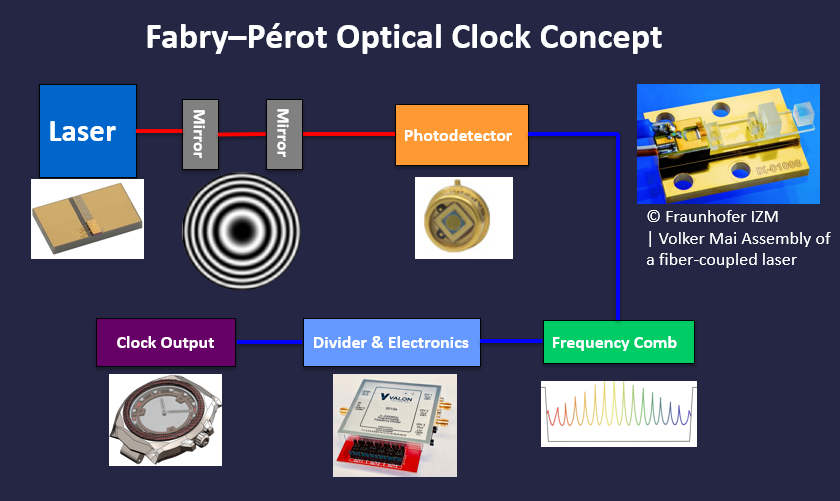The World's Most Accurate Wrist Watch
A Fabry–Pérot cavity is essentially an optical resonator: two parallel mirrors trap light and only allow specific wavelengths (modes) to resonate, with extremely sharp frequency selectivity. Because of its very high Q factor, meaning an extremely narrow linewidth and stable frequency, a Fabry–Pérot cavity can act as the frequency reference for an oscillator, similar to the way a quartz crystal does in a watch.
A Fabry–Pérot cavity typically has a very high Q factor, up to tens of millions or more, since its sharp optical resonances depend on mirrors that confine light with minimal loss. In contrast, the Q factor of a quartz watch crystal is much lower, on the order of tens of thousands, as it is limited by mechanical damping in the vibrating quartz resonator. The difference reflects the much higher energy storage efficiency and narrower linewidth of an optical cavity compared to a macroscopic mechanical oscillator.
In short, a Fabry–Pérot cavity provides a much narrower resonance than quartz, allowing for an oscillator that could, in theory, keep far more accurate time than a quartz watch.

**The image of the IX-01008 is an example of how the guts of the watch could look. reference: © Fraunhofer IZM | Volker MaiAssembly of a fiber-coupled multi-emitter laser on a hybrid bench
1. Laser (Blue Block)
- Provides a stable light source, usually at a fixed wavelength such as 1064 nm or 1550 nm
- The laser’s frequency is locked to the Fabry–Pérot cavity resonance to suppress drift
- Functions as the oscillator of the optical clock, running at hundreds of terahertz
2. Fabry–Pérot Cavity (Gray Mirrors)
- Two highly reflective mirrors facing each other form a resonant cavity
- Only certain optical frequencies resonate, producing a very narrow linewidth with high Q factor
- Serves as the reference element that sets the clock’s precision
3. Photodetector (Orange Block)
- Detects the transmitted or reflected optical signal from the cavity
- Converts light into an electrical signal so the system can monitor and stabilize the laser
- Provides the first electronic representation of the optical frequency
4. Frequency Comb (Green Block)
- A laser that produces many evenly spaced optical frequencies, like the teeth of a comb
- Connects the optical frequency of the stabilized laser to lower RF and microwave frequencies
- Allows the ultra-high optical frequency to be measured and used practically
5. Divider and Electronics (Light Blue Block)
- Takes the frequency comb output and divides the signal step by step
- Uses circuits like phase-locked loops, counters, and digital dividers to reduce the frequency
- Produces stable intermediate signals that can be processed further
6. Clock Output (Purple Block)
- Final usable output, such as a 1 Hz pulse or a 10 MHz reference signal
- Equivalent to the timekeeping signal from a quartz watch but with far greater stability
- Provides a practical clock signal that can be used in measurement systems or time standards
Compare this to the architecture of a quarts clock
1. Quartz Crystal Resonator
- A small piece of quartz cut to vibrate mechanically at about 32,768 Hz
- Uses the piezoelectric effect to convert electrical energy into mechanical vibrations and back
- Acts as the oscillator that sets the timing reference for the watch
2. Oscillator Circuit
- An electronic amplifier connected to the quartz crystal
- Sustains oscillation by feeding energy back into the crystal’s natural vibration
- Shapes the vibration into a stable electrical signal
3. Frequency Divider
- Digital circuitry that divides the 32,768 Hz crystal frequency down to 1 Hz
- Typically a chain of binary counters, since 2¹⁵ = 32,768
- Produces one electronic pulse per second for timekeeping
4. Timekeeping Logic
- Receives the 1 Hz signal from the divider
- Drives the display electronics, whether analog (stepper motor for hands) or digital (LCD)
- Coordinates with additional circuits for alarms, chronograph, or calendar functions
5. Display Output
- The final, human-readable time indication
- Can be moving hands on a dial or digital numerals on a screen
- Provides a practical interface, translating the quartz oscillator’s frequency into visible time
An oscillator is any system that produces a stable, repeating signal by storing and releasing energy in a regular cycle — in watches, quartz crystals vibrate mechanically, while in advanced optical clocks a Fabry–Pérot cavity sets the rhythm with trapped light.
With focused research and funding, it would be possible to shrink today’s lab-scale optical clock technology into a microphotonic wristwatch. By integrating miniature optical cavities, lasers, and frequency dividers onto a chip, such a watch could achieve timekeeping stability far beyond quartz, potentially rivaling scientific instruments, but in a wearable form.
With focused research and funding, it would be possible to shrink today’s lab-scale optical clock technology into a microphotonic wristwatch. By integrating miniature optical cavities, lasers, and frequency dividers onto a chip, such a watch could achieve timekeeping stability far beyond quartz, potentially rivaling scientific instruments, but in a wearable form.